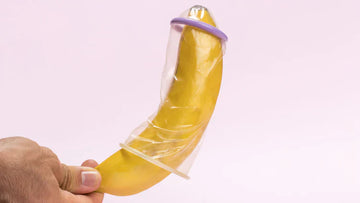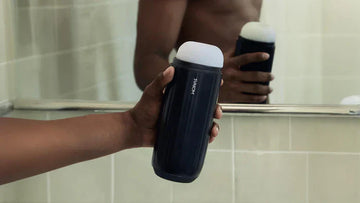What Is a Penis Pump?
A penis pump is a device designed to create a vacuum around the penis, encouraging increased blood flow to help achieve and maintain an erection. The process works by placing the penis inside a sealed cylinder and using either manual or motorised suction to create negative pressure. This negative pressure draws blood into the erectile tissues, resulting in temporary firmness.
While some people explore the idea of a diy penis pump for cost-saving reasons, it is important to understand how it works and the potential risks involved before attempting it.
What Are Penis Pumps Used For?
Penis pumps have a range of uses, including:
- Erectile support for men experiencing mild erectile difficulties
- Enhancement of sexual performance by maintaining a firmer erection during intercourse or masturbation
- Temporary size increase before sexual activity
- Therapeutic uses in penile rehabilitation after surgery or injury
Many men also experiment with penis pumps to enhance pleasure when used alongside male sex toys such as male masturbators or Japanese onaholes.
How to Use a Penis Pump
Whether using a store-bought device or a homemade penis pump, the general process is similar:
- Lubricate the base of the cylinder and your penis to create a better seal.
- Insert the penis into the cylinder.
- Create suction gradually using a pump bulb, lever, or manual method.
- Monitor pressure to avoid discomfort or damage.
- Release pressure using the valve or by breaking the seal.
- Optionally, use a cock ring to maintain the erection after removing the pump.
For first-time users, our guide on 15 Best Homemade Sex Toys for Men offers helpful tips for comfort, safety, and creative DIY approaches to male pleasure.
5 Best DIY Penis Pump Methods
Creating a homemade penis pump can be done with everyday household materials, but extreme caution is necessary. The following five methods are inspired by popular online approaches — with safety advice added.
1. The Plastic Bottle Vacuum Pump
This simple and accessible method uses a common plastic bottle to create a controlled vacuum, making it a popular choice for beginners exploring a homemade penis pump.
What You Need:
- A sturdy plastic bottle (wide enough for comfort)
- Soft rubber or silicone seal (e.g., cut from a glove)
- Manual vacuum pump (from an old blood pressure kit)
- Electrical tape
Steps to Make It:
- Cut the base of the bottle smoothly to avoid sharp edges.
- Attach the seal around the base to protect skin contact.
- Connect the bottle opening to the manual pump via tubing.
- Apply tape to seal all joints.
- Test suction with your hand before actual use.
Why It Works:
The bottle acts as the vacuum chamber, while the manual pump allows controlled suction, similar to commercial pumps.
2. The Mason Jar Method
Using a mason jar allows for a more rigid chamber and precise suction, ideal for those looking to experiment safely with a diy penis pump at home.
What You Need:
- Glass mason jar (smooth inner rim)
- Rubber gasket
- Small hand pump with tubing
- Petroleum jelly or water-based lube
Steps to Make It:
- Place the gasket over the jar’s rim for comfort.
- Drill a hole in the lid to fit the tubing.
- Connect the tubing to the hand pump.
- Seal joints tightly to maintain suction.
- Apply lubricant to the gasket before use.
Why It Works:
The jar’s rigid structure holds a vacuum well, and the gasket helps create a secure, airtight seal around the base of the penis.
3. The Vacuum Storage Bag Pump
A vacuum storage bag can double as a penis pump, offering gentle suction and comfort for those who prefer a low-cost, homemade penispump option.
What You Need:
- Small vacuum storage bag
- Hand pump (included with bag)
- Soft insert or sleeve for comfort
Steps to Make It:
- Place the sleeve inside the bag opening.
- Insert the penis into the sleeve.
- Use the pump to remove air slowly.
- Monitor sensation closely to prevent over-suction.
Why It Works:
Vacuum storage bags are designed to be airtight, and the pump is easy to use, making it a low-effort option.
4. The PVC Pipe Pump
The PVC pipe method provides durability and customisation, making it suitable for users who want a robust homemade penis pump with adjustable length.
What You Need:
- PVC pipe (cut to a comfortable length)
- Soft silicone ring or gasket
- Hand or electric vacuum pump
- Tubing and sealant
Steps to Make It:
- Sand the inside of the pipe edges.
- Attach the silicone ring to one end.
- Connect the other end to tubing leading to the pump.
- Seal with waterproof adhesive.
- Test before body use.
Why It Works:
PVC is lightweight and easy to work with, while providing a rigid structure for vacuum creation.
5. The Modified Water Bottle Pump
By adapting a thick water bottle with a soft base, this method delivers a simple, flexible, and cost-effective diy pennis pump solution for beginners.
What You Need:
- Thick-walled water bottle
- Soft base padding
- Aquarium tubing
- Manual suction pump
Steps to Make It:
- Cut the base of the bottle evenly.
- Attach padding for comfort.
- Connect the bottle neck to the tubing.
- Attach pump at the tubing’s other end.
- Test suction before use.
Why It Works:
Readily available materials make this a quick and inexpensive build, and the tubing-pump combo mimics commercial function.
If you enjoy experimenting with homemade adult toys, check out our full guide on 15 Best Homemade Sex Toys for Men for more ideas.
Will a Penis Pump Make My Penis Bigger?
Penis pumps can create a temporary increase in size by drawing blood into the penile tissue, resulting in a firmer and fuller erection. This is due to the vacuum effect, which helps expand the corpora cavernosa — the two chambers inside the penis responsible for erections. For some men, consistent and careful use over weeks or months may lead to modest long-term improvements in girth, and in rare cases, length.
However, expectations should be realistic. A penis pump is not a miracle growth device; its main benefit lies in improving erection quality, helping with conditions like erectile dysfunction (ED), and enhancing confidence in intimate moments. Once the vacuum pressure is released, the size boost will gradually fade within a few hours.
For men seeking permanent changes, surgical or medically supervised treatments are the only proven options — and these carry their risks. Penis pumps are better viewed as a safe, non-invasive way to temporarily maximise what you already have.
If your goal is to maintain the pumped size for longer during sex, pairing the pump with a cock ring can help retain blood flow in the penis. YOLOVE Toys offers a range of cock rings designed for both comfort and performance.
Can a Penis Pump Damage My Penis?
When used properly and according to instructions, penis pumps are generally safe. However, like any device that applies physical pressure, misuse can cause injury. The most common side effects include temporary swelling, mild bruising, or a tingling sensation due to increased blood pressure in the penis. These usually resolve within hours or days.
Risks of improper use:
- Excessive vacuum pressure can rupture small blood vessels.
- Over-pumping may cause painful bruising or blistering.
- Potential damage to erectile tissue with prolonged or aggressive use.
- Increased risk of long-term erectile issues in extreme cases.
- Men with certain medical conditions (blood clotting disorders, sickle cell anaemia, or those on blood-thinning medication) may experience serious complications.
Safety tips to reduce risks:
- Follow the manufacturer’s recommended pressure limits.
- Limit pumping sessions to 15–20 minutes.
- Stop immediately if you experience sharp pain or discomfort.
- Check the device for damage, cracks, or sharp edges before each use.
- Apply gentle, consistent suction rather than aggressive pumping.
When handled sensibly, a penis pump is no more dangerous than other sexual wellness tools, but caution is essential because penile tissue is delicate and sensitive.
DIY Penis Pump Risks
Creating your penis pump at home may sound appealing as a low-cost alternative, but it carries significant safety risks. Commercial pumps are designed with medically safe materials, controlled pressure mechanisms, and secure seals to prevent injury. DIY versions, on the other hand, may lack these essential safety features.
Common DIY hazards include:
- Unregulated pressure: Without a proper gauge, you may apply excessive suction, leading to vascular damage.
- Unsafe materials: Household items like plastic bottles or tubing may contain harmful chemicals or have rough edges that can cut the skin.
- Poor sealing: Air leaks or unstable suction can cause uneven pressure and increase the risk of injury.
- Infection risk: Non-sterile materials can introduce bacteria, causing skin irritation or more serious infections.
While DIY solutions can be creative, the penis is not an area to experiment with unsafe equipment. Even a single misuse can cause lasting damage to erectile tissue or sensitivity.
If cost is the main concern, consider affordable, entry-level pumps from reputable brands. These are engineered for safety and performance, making them a far better investment than risking injury with an improvised device. Remember — a safe experience is always better than a risky shortcut.
Why Buying a Commercial Penis Pump Is Better
Commercial penis pumps are:
- Made from body-safe materials
- Equipped with safety valves
- Pressure-tested for safety
- Designed for comfort and durability
For example, YOLOVE Toys offers male sex toys and professional-grade pumps that outperform any homemade penile pump in safety and results.
Alternatives to DIY Penis Pumps
If you want a similar experience without the risks, try:
- Cock rings for erection support
- Male masturbators for pleasure
- Onaholes for varied sensations
You can also explore other DIY options such as a homemade pocket pussy or a DIY dildo for additional male pleasure experiences.
Technical & Legal Disclaimer
This article is for informational purposes only. Any attempt to create a diy penis pump is done at your own risk. YOLOVE Toys does not endorse unsafe practices and recommends using certified, commercial-grade devices.
FAQs
How to make a homemade penis pump?
Use safe materials, airtight seals, and test the vacuum before use. Keep suction gentle.
Is a homemade pennis pump safe?
Only if made carefully with safety in mind—but commercial products are safer.
How to penis pump without injury?
Start with low suction, limit time, use lube, and stop at any sign of pain.
Which DIY method is safest?
Plastic bottles and PVC methods are safer than glass, but not as safe as professional pumps.
Takeaway
A DIY penis pump can be built from common materials and offer temporary enhancement, but safety risks are real. The five methods above give you options if you choose to go the DIY route—but for long-term, injury-free pleasure, commercial penis pumps and penis extenders from the trusted adult sex toy shops such as SECRET MEOW Toys are the best choice.



